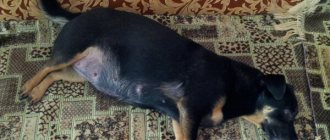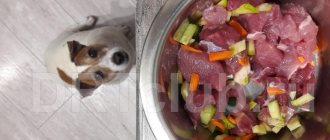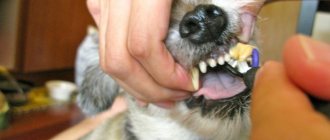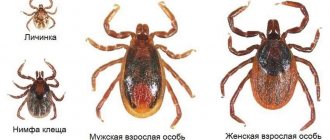Pregnancy in a dog lasts 60-62 days. However, viable offspring can be born at 58 days and up to 72 days. The gestation period varies depending on the breed of the animal. In large dogs and “pocket” dogs it can differ significantly.
Usually dogs give birth easily and humans do not need to interfere with the process. Difficulties can arise during the first birth and in very small dogs. In this case, you need to have the veterinarian’s phone number so that you can contact him if something goes wrong.
The birth of puppies for your pet is a great joy and, at the same time, responsibility. It is important to recognize the onset of labor.
How long does labor last in dogs?
Normal labor lasts from 3 to 12 hours. 15-20 minutes after the birth of the first cub, the placenta comes out and the next puppy is born. In multiple pregnancies, the intervals lengthen to two hours.
If the process of expulsion of fruits continues from 12 to 24 hours, whelping is considered complicated. Pathological childbirth lasts longer than a day.
Preparing and arranging a place for animals
The gestation period for puppies ranges from 59 to 63 days. You need to prepare for the upcoming birth in advance, several weeks before this important day. You need to agree with a doctor, because his presence is necessary, especially during the first birth or insufficient experience of the owner.
8-10 days before giving birth, it is necessary to arrange a place where the bitch will whelp. You need to prepare it in advance so that it gets used to the new place. The best option is to use a playpen or a fairly large box. This place should not be located on or on a cold floor.
You can give birth on a bed or sofa covered with oilcloth. It is necessary to avoid contact with carpets and palaces (it is generally better to remove them), because the upcoming process will be quite “dirty”.
It is necessary to arrange a place where the bitch and newborn puppies will be. A good option is to use a playpen or part of the room that needs to be arranged so that the puppies cannot get out. It is necessary to avoid hypothermia of the mother and offspring; for this purpose, you can use an infrared lamp or place a heating pad under the nest. But please note that you need to avoid overheating the dog (this can cause the onset of bleeding) and puppies (the best temperature for them during the first 10 days is +28, in the future it must be gradually reduced).
Preparing for childbirth
Pregnancy lasts two months. You need to prepare for childbirth in advance: decide on a place for a den, select the necessary tools and materials for obstetrics and receiving newborns.
What you will need
You need to prepare the following items:
- oilcloth, clean sheets that you don’t mind throwing away;
- baby box;
- scales;
- sterilized scissors;
- suture material;
- alcohol, brilliant green;
- thermometer;
- syringes;
- Vaseline or baby cream;
- antiseptic ointment;
- solutions of ascorbic acid, glucose 5%, calcium gluconate 10% for injection.
- warmer;
- trash bin.
You should have a veterinarian’s contact number, a notepad and a pen on hand to record data on the live weight of newborns, the order and circumstances of their birth.
Place for birth
They select a box or playpen into which the bitch is placed when she begins to nest. Choose a place where no one will disturb the pet. Clean bedding and favorite toys are placed in the den, which are removed when signs of childbirth appear.
At home or in a clinic?
The following indications are available for whelping at home:
- In most cases, bitches whelp without problems. They do not require the help of a veterinarian or even an owner.
- Minimize stress during transportation to and from the clinic. The expectant mother gets used to the den.
- The veterinarian examined the pet before giving birth, recommended whelping at home, left a contact phone number, and promised to come to the house if the need for his services arises.
- There are no additional costs required to keep an animal in the clinic.
The dog owner needs to master the skills of cutting, tying and cauterizing the umbilical cord, cleaning babies from mucus and amniotic sac.
Whelping is carried out in the clinic when the following indications exist:
- Breed predisposition to pathological childbirth.
- Previous births were difficult and ended in caesarean section.
- The birth of stillborn or weakened cubs in a previous pregnancy.
- The use of medications to preserve pregnancy.
The dog owner must make a decision on his own: where to give birth to his dog - at home or in a clinic. During surgery, a sterile room, equipment, instruments, and a team of veterinarians will be required.
How to understand that childbirth is near
A week before whelping, the belly drops; if you examine the bitch from above, it seems that she has lost weight. Hair falls out around the nipples. The dog begins to nest - fuss, look for a place for a den.
3-5 days before whelping, whitish mucus is released from the vulva. 2 days before the event, the bitch begins to constantly lick the genitals. The udder enlarges, the nipples swell, and sometimes colostrum is released from them. In the middle of the ninth week of gestation, thermometry should be carried out. A drop in temperature below 37°C for large bitches and 36°C for small bitches occurs 12 hours before whelping.
Pet behavior before birth
Most bitches become timid; an unexpected meeting with other animals or the raising of the owner's voice can have a detrimental effect on her condition. The dog becomes calm, plays less often and is active. Even temperamental breeds show sedateness and complaisance. Usually, bitches are more affectionate during pregnancy and require the support and attention of the owner. Appetite changes - in the early stages it decreases, and then greatly increases. If the dog does not eat at all, it is recommended to consult a specialist.
As whelping approaches, the bitch begins to look for a quiet and secluded place in the house and refuses to eat. When giving birth is imminent, the bitch shows anxiety - she scratches the floor, whines and walks in circles in one place.
Photo: flickr.com
Childbirth process by stages
The following stages of normal childbirth are distinguished:
- Contractions are contractions of the muscles of the uterus.
- Attempts to contract the muscles of the abdominal wall. The water breaks and the puppy is born.
- Expulsion of the placenta.
Contractions last from 2 to 24 hours. The second and third stages of whelping occur and end many times, depending on the number of cubs. During a normal birth, 15-30 minutes after the placenta leaves, the next baby is born. After the appearance of 4-5 cubs, there is a break and the next series of puppies comes out.
The bitch herself frees the baby from the shell, gnaws the umbilical cord, licks the newborn, who immediately finds the nipple. The owners help the pet: free the baby from the placenta, cut the umbilical cord, bandage it, burn the stump with alcohol or brilliant green.
Help from the owner to the dog
The dog may need immediate delivery. First of all, attention needs to be paid to the puppies. If one comes out, but the mother does not pay attention to him, then the owner will have to cut the umbilical cord. This must be done carefully and in accordance with the rules.
- You need to tie the umbilical cord with a strong thread an inch away from the puppy's body.
- The second thread needs to be tied a few centimeters from the first.
- After this, you need to cut the umbilical cord using sterile scissors.
While the mother is giving birth to one puppy, another may need help. It is necessary to rupture the placenta that envelops the newborn. After this, you need to wipe the puppy’s body with a clean towel against the growth of the fur so that it makes a sound.
If the mother has not started licking the puppy, its airways may be filled with fluid. Don't shake your newborn. It is recommended to gently wipe the puppy's mouth with your little finger, and then the nose. After this, you should rub the puppy’s belly with a towel so that he begins to breathe, breaking through the plug.
How to deliver a dog at home
When intense contractions begin, the bitch should lie down on her side. Sometimes animals give birth standing up. Shortly before labor begins, the amniotic sac bursts and the water breaks.
There is no need to help your pet with this by trying to pierce the bubble.
From the moment the birth canal is washed with water, contractions become as intense as possible.
No more than three hours pass before the first puppy appears. If this time drags on, call veterinary help immediately! Complications may arise that could cause you to lose both mother and offspring.
At birth, pushing becomes prolonged and very painful. The abdominal muscles and diaphragm actively contract. Babies come out with both their muzzle forward and their hind legs - this is normal. Your task is to help the pet by accepting newborns.
Each baby is born in its own amniotic sac. Usually the bitch chews it herself. If she does not do this, break the bubble yourself and free the newborn as quickly as possible so that he can breathe. If he does not move, is covered in blood or greenish mucus, clean his mouth and nose as quickly as possible, and clear his airways of fluid.
Your help will also be useful in cutting the umbilical cord. If for some reason the bitch does not do it herself, help her. Gently push the blood in the umbilical cord towards the baby. With one hand, pinch the umbilical cord 3 cm from his tummy, with the other - 2-3 cm from the first hand.
Cut off the umbilical cord with the hand closest to the newborn, holding the other motionless and firmly. It’s better to just cut it off - there’s practically no blood this way. If you still had to cut it with scissors or if blood came out when it was cut, tie it with silk thread, previously disinfected.
Cut the umbilical cord quickly, do not allow the dog or the puppy to pull on it - this can cause an umbilical hernia.
After every birth, the placenta comes out. Often she is pushed out by the next one behind the newborn. You have to wait the longest for the latest one to come out. Record the number of afterbirths released - it should coincide with the number of births. At the slightest suspicion that one of them has not left the birth canal, be sure to show the dog to the veterinarian. A failed placenta can lead to serious inflammation of the uterus.
Childbirth and the delivery of the placenta is a messy process and fertile ground for the development of infections. Keep it clean, try to change the bedding after each puppy comes out.
After cleaning the amniotic sac from the baby and cutting the umbilical cord, hand it over to the mother. She will lick the newborn, nudge him, stimulating breathing and blood circulation. Try to get newborns to the nipples as quickly as possible. Sucking will help the uterus contract more intensely.
After the first sips of colostrum, puppies expel blackish meconium, the original feces. This starts the digestive processes. If the baby is weak and cannot cope on his own, help him by lightly massaging his stomach and anus with a damp cotton swab.
Try to protect the bitch and newborns from anxiety. Keep them in a room where people do not often go, keep strangers away. Provide your pet with peace and safety.
Briefly about the main thing
- Gestation of puppies in dogs lasts from 52 to 72 days. The time depends on the characteristics of the animal (weight, age), and pregnancy.
- Small breeds are more likely to experience complications during childbirth.
- After fertilization, the dog becomes passive and affectionate. Appetite changes - first it decreases, then it increases.
- An early birth can be determined by physiological signs - changes in body temperature, discharge from the loop, release of the plug and contraction of the uterus.
- After the first contractions appear, it is advisable to consult a veterinarian for obstetric care.
Features of childbirth in different breeds and sizes
Dogs of large, small, short-faced breeds are prone to pathological whelping. Great Danes, Labradors, Bullmastiffs, Pugs, Bulldogs, Toy Terriers, and Yorkies are at risk.
The dog owner should consult with a veterinarian or dog handler and find out whether the animal is at risk for birth complications.
Means necessary for childbirth
When delivering a baby, you need to sanitize your hands and put on unnecessary clothing, which can then be disposed of.
The main condition is the presence of the so-called “obstetrician’s kit”, which contains:
- Oilcloth lining and sheet;
- Hot water bottle;
- Puppy crate;
- Container for used materials;
- Thermometer;
- tray;
- Sterilized scissors and tweezers;
- Syringes;
- Dressing material (cotton wool, napkins, diapers)
- Disinfected threads;
- A notebook, which should contain the number of the veterinary service and a pen;
- Watch;
- Weights;
- Colored threads to represent puppies;
- Alcohol;
- 5% glucose ampoule solution;
- 10% synthomycin ointment;
- Hydrogen peroxide and brilliant green;
- Traumeel.
In a situation of premature birth and the absence of a doctor, you need to have with you such injectable drugs as: calcium gluconate, oxytocin, dicynon, analgin, no-shpu, diphenhydramine, saline solution, dexamethasone, vitamin B12.
A day before giving birth, you need to treat the bitch’s abdomen and external genitalia, cutting off the hair before doing this. If the breed is long-haired, the fur can be tied with rubber bands. For several dog breeds, it may be necessary to trim the mustache and beard to prevent the umbilical cord from being bitten.
Inducing labor in a dog
The need to stimulate whelping arises in the following cases:
- pregnancy lasts 10 weeks or more;
- 24 hours have passed since the onset of labor, but the puppies have still appeared;
- 2 hours have passed since the puppy was born, and the new cub has not yet appeared.
There are medicinal and bodily stimulation.
Medication
A dog breeder can use the following medications without harm to the pet’s health:
- Ascorbic acid, 5%, intramuscularly from 2 to 3 ml.
- Glucose 5% subcutaneously, 5 ml/kg.
- Calcium gluconate, 10% - 5 ml/10 kg of weight, intramuscularly.
Other medications are prescribed by your veterinarian.
Corporeal
Massage is carried out after providing medical assistance.
Stimulation consists of the following manipulations:
- massage the belly from head to tail;
- lubricate fingers with cream or Vaseline, rub the perineum in a circular motion;
- express colostrum, stroke nipples;
- massage the vaginal walls with clean fingers with trimmed nails, covered with antiseptic ointment.
Vaginal massage is combined with stroking the abdomen. If after three minutes the expected result does not occur, the manipulation is repeated after a quarter of an hour. If induction of labor does not work, seek veterinary help.
Condition after childbirth
After the process is completed, the bitch will continue to discharge for some time. If everything went well, they will be brown in the first few hours, but over the next few days (or even weeks) they will be white or yellowish. Bloody or any other discharge with an unpleasant odor is a clear sign of pathology, which means a reason to immediately consult a doctor. This may mean that the pet has some kind of injury or that the placenta remains inside.
If the birth was successful, after a few hours it is necessary to change the bedding of the mother and puppies and offer the bitch a drink. Feeding should be made more frequent, with small portions - so that the dog has time to eat and does not feel hungry. It will be useful to include milk, cottage cheese and kefir in your diet.
No matter how your pet’s whelping progresses, if you are not confident in yourself, it is better to call a veterinarian at home. He will tell and show how to deliver a dog and what to do in unforeseen situations, and will also be able to monitor the onset of labor.
Do you like the article? 417
When you can't do without a veterinarian
Veterinary assistance will be required in the following situations:
- A foul-smelling discharge from the vulva appeared.
- Labor continues for more than 12 hours.
- Contractions last more than 150 minutes, but labor does not occur.
- 3 hours have passed since the last puppy came out, but the contractions continue.
- Bleeding occurred.
- The babies are still born.
- Convulsions began.
Before whelping, you need to agree with a veterinarian who will agree to provide assistance at home.
Postpartum period
The postpartum period is the time after the delivery of the placenta until the uterus is restored. Uterine discharge can last up to three weeks. At first they are greenish or brown with a neutral odor, later they become transparent. Pathologies are the depressed state of the mother, foul-smelling discharge.
It is necessary to provide the mother with a balanced diet and special vitamins. The dog needs to be fed at least 6 times a day in medium portions. Give milk or water every 2-3 hours.
The owner must know how to understand that his dog is giving birth, and how they are born in principle. This knowledge will help save the animal in case of complications, and therefore you should approach this process with confidence.
Possible complications
During childbirth, dogs experience the following complications:
- weakened labor;
- non-elastic vaginal walls;
- “dry” birth;
- a dead, abnormally walking or large puppy;
- retained placenta;
- the puppy got stuck;
- narrow pelvis
Weak labor
After prolonged pushing, contractions stop and labor stops. They carry out medical and physical stimulation of labor or remove the offspring by caesarean section.
The vaginal walls are not elastic
Complications arise during the first whelping. After the first baby appears, the vaginal walls become elastic. But the problem is that the bitch cannot give birth to her first child.
The owner should invite a veterinarian who will inject petroleum jelly into the vagina and
Dry birth
When the water breaks before the baby is born, the fetus becomes stuck in the birth canal and its advancement causes pain. The problem is solved by introducing Vaseline oil into the vagina.
Dead, large or abnormally walking puppy
When a dog pushes for 2 or 3 hours and the baby does not appear, it means it is coming out incorrectly, too large or dead. In all cases, you need to call a veterinarian. In such cases, a caesarean section is indicated.
Retained placenta
After childbirth, it is necessary to count the number of placenta: it should be equal to the number of newborns. The last placenta usually comes out on its own.
If this does not happen or the separation of the placenta remains unnoticed, massage the abdomen and inject 1 or 2 ml of oxytocin subcutaneously. Sometimes the bitch eats the child's place. You can't give more than two. It is necessary to take into account the afterbirth eaten.
Puppy stuck
When a baby is stuck in the birth canal, an intramuscular injection of the antispasmodic No-Shpa solves the problem. Veterinarians adapted the drug for the treatment of dogs. Smooth muscles relax 3-5 minutes after administration of 1-2 ml of the drug.
Narrow pelvis
A congenital anomaly or a juvenile developmental defect makes childbirth impossible. The life of the mother and the offspring is saved by a caesarean section. Before breeding a bitch, her reproductive abilities should be assessed.
How to understand that childbirth is near
As the cherished day approaches, the bitches' behavior changes. They become more excited, fussy, looking for a place where the process will take place. Over the course of one and a half to two weeks, the stomach begins to gradually change. This happens because the fetuses are approaching the birth canal. Visually, it seems as if the stomach has shrunk a little - this is a natural process, there is no need to worry.
At the same time, the expectant mother begins to lie down more and more, since it is already difficult for her to walk. It's time to find a place where the process will take place and learn how to deliver a dog.
When there are only a few days left before whelping, mucous discharge from the vagina appears. This is how the cork comes out, which prevented the fruits from being born ahead of schedule. Most often, the plug comes off unnoticed.
Sometimes discharge also appears from the nipples - especially if the bitch is pregnant not for the first time. This stage can be easily determined by the characteristic behavior of the animal. She licks herself often and spends quite a lot of time doing this, and stains remain on her bedding or diaper.
Signs of the onset of labor in a dog and the process itself are difficult to miss. A few hours before giving birth, the pet’s water breaks, which contained the fetuses. This means that she will give birth very soon, which means it’s time for the owner to prepare.
Postpartum recommendations and dog nutrition
Mothers with offspring provide peace. A lactating female needs 3 times more calories than a single female. At the same time, they take into account that the pet cannot eat a lot of low-calorie food: the stomach puts pressure on the uterus, which has not yet recovered from childbirth and hurts. Therefore, the diet should contain energy-rich, easily digestible foods. The need for minerals and vitamins increases. The veterinarian will advise what fertilizer to use and in what quantity.
Responsible dog breeders switch a pregnant bitch to ready-made puppy food of at least super premium class. Pellets should be in the feeder at all times. Ready-made food increases milk production and reduces weight loss. The puppies watch their mother, visit her feeder, and easily switch from liquid milk to solid milk.
Positive aspects of breeding dogs
The instinct of motherhood in an animal is the most powerful manifestation. A dog in heat strives for fertilization by any means. Satisfaction of this instinct will give the animal an undeniable benefit. A dog that gives birth lives longer. The emotional area of the animal will certainly acquire positive impulses. Dogs constantly feel proud of their own offspring.
After giving birth, the female gains new strength. The dog is full of beauty and energy and quickly gets used to being a mother. The owners of the animal also gain a huge advantage, since dog owners treat their babies with great trepidation and continue to care for them, including after they are given away.
Of course, there are also disadvantages, since not all owners are able to withstand the birth process. Owners are afraid for the dog’s health, and also list the possible costs of caring for the pet. Most owners do not pay attention to such shortcomings, because a dog in the house is always a joy. Read the positive points again and all worries will dissipate on their own.
Remember, if there are no necessary conditions, then you should not buy a dog. She needs to be fed at the same time every day. Irregular feeding has a bad effect on the animal's digestion. The same applies to mating a female, if you are not ready for the process and especially for the resolution of childbirth, think before you make a purchase. When you are unsure of your personal abilities or may be at a loss if complications arise, go to the nearest veterinary hospital and arrange with the doctor about the birth.
Giving birth to a dog is not exactly a difficult process, but rather exhausting for its owner. Childbirth sometimes takes a very long time and unforeseen circumstances may arise. The birth of puppies is a joyful event, in which you cannot do without worrying about your own dog and its offspring.
But there is no need to panic under any circumstances. You must be attentive and collected in order to provide assistance to your pupil at any moment or promptly arrange for a veterinarian to come to your home. The process of childbirth has been regulated by instinct for centuries. The dog will do everything on its own. You must provide moral support and help in case of urgent need.
Currently reading:
- Is it worth it or not to include natural food in your dog’s diet?
- Seven Signs and Remedies for Getting Rid of Fleas in Dogs
- Why does a dog bite and how to stop it from doing so?
- Recommendations for obedience of a dog if it growls
And what should come after?
After the third stage of labor - the departure of the placenta - the postpartum period begins, which begins after the expulsion of all placenta and lasts until the uterus and other genital organs of the female are completely restored.
An alarming signal during this period is bleeding for more than 3 weeks, depression, fever. This may indicate that puppies or placenta remain in the uterus and bleeding has begun.
In the first two to three days, the temperature may rise to 39.9˚C, this is associated with the arrival of milk.
Causes of labor
Childbirth is the result of a whole complex of reasons. Experts conditionally divide them into three groups. The first group is the reasons preparing for childbirth; the second - causing them and the third - supporting labor.
Experts include the following reasons for the first group:
A strong decrease in the excitability of the cerebral cortex, causing an increase in the activity of the subcortex and sexual center, a decrease in anti-contractile substances, an increase in the excitability of the neuromuscular apparatus of the uterus, an increase in the content of relaxin, which causes relaxation of the ligaments of the pelvis and its symphysis.
The reasons of the second group include:
Accumulation of highly active estrogens, against the background of a decrease in progesterone levels. This is facilitated, in particular, by impulses emanating from the fetus. Thus, as a result of activation of the function of the fetal adrenal glands, an increased amount of corticosteroids involved in the synthesis of estrogens and the release of prostaglandin (PGF2a) enters the placenta. Under the influence of prostaglandin, secreted by special cells of the placenta and endometrium, the function of the corpus luteum in the bitch ceases, and the level of progesterone drops.
With the participation of estrogens, a morphological and biochemical restructuring of the myometrium occurs (accumulation of contractile protein, glycogen, phosphocreatinine, calcium, etc.), the excitability and sensitivity of the uterus to mechanical (fetal movements), chemical (oxytocin, acetylcholine, serotonin, prostaglandins, etc.) increases. d.) and other irritants that affect uterine contraction. At the same time, the activity of the stimuli themselves increases.
The reasons of the third group include: the action of acetylcholine, which maintains the rhythm of the birth process, mechanical irritation of the paracervical and paravaginal ganglia, which reflexively cause contraction of the uterine muscles. Contractions of the uterus, in turn, reflexively excite contractions of the abdominal press, which causes the removal of fetuses from the birth canal.
Thus, childbirth occurs as a result of the complex integrated action of a number of neurohumoral factors, carried out under the control of the central nervous system, its highest department - the cerebral cortex, in which the dominant of labor is created.
First moments of newborn puppies
Puppies are born at intervals of 15-30 minutes.
When delivering a baby, you need to take notes on:
- Weight and moment of birth of puppies;
- Appearance sequences;
- Field;
- Color;
- Other appearance features.
Each puppy is licked by a bitch after birth. They find their way to the nipples, but not all babies succeed, so we need to help them. Application to the nipples speeds up labor and helps the uterus contract better.
Another positive side of the quick application is that colostrum, entering the baby’s body, stimulates intestinal function.
Rules for walking in the postpartum state
Dogs show unusually great care for their cubs, so it will not be possible to walk the bitch for a long time in the first days after giving birth, because she will be eager to get to them. The duration of the walk should be 10-15 minutes. Up to 4 times a day. Its duration increases over time.
The bitch needs to be walked, this helps her milk flow and helps her get back into shape. After completing the walk, the dog's nipples must be washed and dried with a towel. And only then let them approach the puppies. To protect the mammary glands from contamination, sagging, insect bites and injuries, you can put a special blanket on your dog before a walk.
4.6 / 5 ( 14 votes)
Is it possible to change this indicator with the help of medications?
If your body heat increases or decreases during, before or after childbirth, do not self-medicate. Contact your doctor immediately or invite him to your home ; perhaps the dog is cold or too hot; you need to wrap it up, lower the temperature in the room, or wipe the dog with cool water. In this case, you can use any medications only after the recommendation of a doctor.
Can you make a bitch give birth?
Labor starts under normal conditions when the puppies are ready to go out and survive on the streets. There is nothing that can cause this ripening. Therefore, no home remedy will cause your dog to go into labor and is not recommended to try. If we really want to know how to help a dog give birth, the best way to do this is to create a relaxed environment in which the hormones that need to be activated during labor can work without stress.
The other situation is the one we discussed in the previous section. When the bitch is already in labor and the veterinarian administers medication to activate it if the uterus doesn't seem to be doing its job. This is a veterinary procedure that can only be performed by a professional.
Author of the article : Maria Besteiros.











